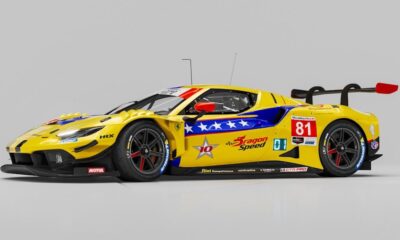
Photo: IMSA
The days of Balance of Performance controversy in the Prototype class should be no more in the newly structured class, according to IMSA’s Mark Raffauf, who is optimistic of achieving a proper balance between the 2017-spec LMP2 and DPi machinery.
Both new platforms, as well as grandfathered 2016 IMSA-spec LMP2 coupes, will make up the new-look P class next year, marking a significant departure from the previous-generation DPs, which were performance balanced to the current IMSA P2 cars for the last three seasons.
“It’s not going to be a constant exercise as it is now with two different kinds of cars that perform differently,” Raffauf told Sportscar365.
“These cars should function the same way and if the aero work done in advance is done right with the right results, they should have enough tools allowed to [teams] to either get it right or get it wrong in a race-by-race basis.
“We’re trying to back away from the concept of telling them precisely how the car has to be run and let them run it themselves.”
IMSA’s DPi regulations will allow further aero modifications in addition to each car’s base homologation, which Raffauf said is being created within an aerodynamic “target box” that’s applicable for both LMP2 and DPi platforms
“[DPi cars] will have aerodynamic add-ons and bits and pieces and various things they can play with that will be a little bit more geared towards inner-team competition,” he said.
As previously announced, the DPi cars will be both performance and aero-balanced to the Gibson-engined LMP2 car, which will serve as the performance baseline for the P class.
Despite having different electronics, both types of cars will be equipped with the same IMSA-mandated data logger system.
Raffauf said the plan will be to accept each FIA/ACO-spec LMP2 car, as homologated by each of the four approved constructors, without any major modifications, except for possible “initial variables” that have yet to be detailed.
He doesn’t, however, expect any issues matching the engine performance from the various DPi manufacturers to the global-spec 4.2-liter V8 Gibson powerplant, which is rated to deliver in excess of 600 horsepower.
All DPi and LMP2 machinery will be put through full-scale wind tunnel testing later this year, in order to finalize the BoP.
“The LMP2 car, because it’s not styled, is 100 percent functional,” Raffauf said. “The DPi car has some styling elements, with the result having less aerodynamic efficiency.
“The [scale] model stage we’re going through right now is to really make sure what we’re starting with, before going to full-scale, can be made to be good enough, aerodynamically.
“If it underachieves, we can raise our hand and say, ‘Hey, we need to work on this a little more because it’s not going to be possible to get in the performance window it needs to be in.’ Because you can over-style this.
“There’s a certain level of functionality that is necessary on a styled body that if you don’t have you simply cannot compete aerodynamically. And if you can’t compete aerodynamically with these cars, you really can’t compete.”
Raffauf said the two bodywork designs that are in the final stages of approval, widely believed to be from Cadillac and Mazda, are “quite distinctive” but are now both within IMSA’s target box.
With both manufacturers not likely to formally announce its DPi programs until mid-to-late November, Raffauf said he expects the initial DPis to not be running in its final bodywork packages, at least in public testing.
“They may go test it extensively in secret somewhere, and we may never see it until that announcement comes,” he said.
“Judging from the sophistication of our process and the sophistication of the constructors, I think you can get to a certain point where the performance is predictable.
“So getting the systems to physically work on the car is probably, certainly for a 24-hour race, going to be more important to get that right. If that part works, then the speed becomes a more predictable part of the package.”
While the cars, in its final configuration, may not be seen on-track, publicly, until December, the aero packages will be locked in for the entire 2017 season, with manufacturers only allowed to request changes mid-year for the following season.
Such changes would be aimed for re-branding, and not necessarily performance related, Raffauf said.
“If they want to change the body, they can, but they have to apply for it, with a pretty good reason and then go through the whole process of model and full-scale. It would be re-evaluated as a new car,” he said.























